TOP: The Dagmar Custom Guitars Vicky model. BOTTOM LEFT: The crown from the Vicky tailpiece is a nod to Queen’s University’s role in developing photonic pickup technology on the guitar. BOTTOM MIDDLE:
Vicky’s headstock. BOTTOM RIGHT: Custom lightning bolt inlays on the Vicky model. Photos courtesy of Queen’s University
Mark Trokanski had just decided he was done acquiring guitars when he came across a photo from the Montreal Guitar show that stopped him dead in his tracks. He saw four archtops with completely rounded edges and lightning-bolt soundholes, two of which featured a checkerboard pattern around the curved rims. These instruments sat atop a table labeled “Pete Swanson.”
These guitars were so visually striking that Trokanski ceased reading entirely and simply stared at the instruments, which were unlike anything he’d seen, yet somehow seemed familiar. A 25-year guitar collector and medical researcher, Trokanski already had at least 20 guitars, but he’d never had one made specifically for him from scratch, and the idea of commissioning a piece of playable artwork was too intriguing to ignore.
As days went by and he was unable to put the novice luthier out of his mind, he drafted a letter of introduction and began inquiring about the work. And so commenced a months-long courtship (as they both now describe it) between the builder and collector.
“We were sussing each other out,” says Trokanski, “because the relationship between the luthier and the player is an interesting one. This is someone who you’re going to trust to turn your vision into reality.”
For some reason, Trokanski had absolute faith and trust in the newcomer from the get-go, and after a few communications, things took an abrupt turn. “It was very surreal,” Swanson admits. “All of a sudden Mark said, ‘Okay, I want to move forward, so what do we do next?’”
Perhaps Trokanski was taking a risk. After all, at this point the Canadian builder had made only six guitars and was a novice in the guitar world. But he had a knack for using mathematical calculations to determine how to manipulate wood—a skill he’d developed in the early 2000s building interiors for yachts. It seems Swanson’s background was the perfect storm: Before taking on woodworking, he was a graphic artist, and what he learned about drafting sketches or 3-D rendering, he now applies to his guitar designs.
Dagmar’s Working Girl guitar has blonde flame maple
in the houndstooth binding alternating with a black
epoxy dust mixture, which luthier Pete Swanson calls
“reclaimed wood.“
Yet to understand the genesis of Dagmar Custom Guitars, says Swanson, you have to go back to the weeks leading up to his daughter’s 16th birthday. A friend of his had been cleaning out his garage and was looking to unload a ’60s Canadian bicycle. Swanson saw an opportunity to salvage it and create a one-of-a-kind birthday gift, and with visions of hot rods dancing in his head, he brought the bike home and started tinkering.
“I made a wooden tank and a checkerboard dial for the frame,” he says, “and then when I started to adorn the bike, I thought it would be really cool to do matching fenders.” But he had never made bike fenders before, and wasn’t quite sure how he was going to do it. Almost the very next day at work, Swanson observed a coworker experimenting with an urn to hold the cremains of their boss’ recently deceased father.
“He was taking thin strips of wood cut to specific angles on each side,” Swanson explains, “and at the end of the day he had this octagon-shaped vessel. He then rounded the corners with a belt sander and it became this smooth vase. That night I woke up with a eureka moment thinking about how I could build the fenders by using his technique.”
Dagmar Custom Guitars team of collaborators at the Montreal Guitar Show, from left to right: Mark
Kett, Mike McAvan, Denise Trokanski, Mark Trokanski, luthier Pete Swanson, Annette Swanson
(Pete’s wife), and Ian Belknap.
Lo and behold, it worked, but Swanson didn’t stop there. Always an innovator, he decided to further experiment, creating a ducktail fender using the same process. “As soon as I realized I could reverse the curve,” he says, “I immediately thought of a guitar.”
A Guitar Is Born
Swanson started to mentally map out what
would be his prototype guitar. Around the
same time, he enrolled in a business class at
a local college with intentions of debuting
his own brand of custom one-off guitars.
He registered his new company’s name,
Dagmar Custom Guitars, in August 2008.
Swanson named his enterprise after Dagmar, a 1950s starlet whose real name was Jennie Ruthy Lewis. Dagmar was curvy—much like Swanson’s designs—and although she usually played stereotypical “dumb blonde” roles, she was revered for her intelligence and wit. Swanson’s affinity for hot rods and all things beautiful made “Dagmar” an obvious choice. In the 1950s, the term emerged as a slang word for bullet-shaped Cadillac bumpers, a nod to the rocket bra made popular by Lewis on various American television shows. (In 1951, Dagmar was featured in her trademark costume on the cover of Life magazine, and during the Korean war a self-propelled anti-aircraft tank was dubbed Dagmar’s Twin 40s in her honor.)
Swanson calls his first guitar (named Ruthy) “fairly simple,” despite the revolutionary process he used to build it. Like all of his designs, the outside is completely round, and the inside parabolic and smooth. The sides are put together with more than 80 pie-shaped segments—think keystones in Roman arches. When the “keystones” are bonded together they form the guitar shape.
“When you add compound curves to a structure,” says Swanson, “the result is a tremendous increase in strength. My guitars do not depend on the top and back plates to counteract the 150 pounds of tension created by the strings.” Essentially, the top and back of the instrument suffer less stress and are freer to vibrate.
Swanson shapes the guitar’s curvaceous body by hand using digital calipers to ensure the thickness stays consistent. To increase sustain, he graduates the thickness in spots, leaving more mass near the neck and fading thinner and thinner near the waist. The inside is laminated with carbon fiber, making the entire structure rigid, yet lightweight. The result is a focused, punchy sound that Swanson and Trokanski compare to an amphitheater effect.
So far, all of Swanson’s necks have been bolt-on, and he says they weather better than others due to increased stability from nine laminations and a carbon-fiber fitting that acts as a small sleeve. It’s epoxy-bonded into the body and fits the neck heel and tenon. A single bolt goes through the neck block and is tightened with an Allen key. Then a thick heel cap is doweled and epoxy-bonded to the body to extend the neck joint. There’s also a small bolt that goes through the heel cap and into the neck heel, which serves as an anchor.
1. The ABS 3D-printed mold is filled with three-part liquid foam.
Once the foam is cured it is released.
2. A simple spinning jig was made to hold the foam buck while the
CNC flame-maple houndsteeth are plugged into position.
3. An epoxy and ebonized wood dust mixture is frosted in between
the flame-maple houndsteeth.
4. The cured ebonized material is then shaped and faired to flow
with the maple teeth.
5. It worked! The foam is knocked out and the houndstooth rim
becomes freestanding.
6. Next the interior surface is faired to a perfect surface for the carbon
fiber laminations.
7. The carbon fiber is laid in, painstakingly faired, and
polished to perfection.
8. Voila! A one-of-a-kind, parabolic Dagmar body binding.
Pictured here are the front and back of the Dagmar Denise model. Denise features a flamed-maple, double-cutaway body, a bolt-on
neck, a Bigsby, and lightning-bolt inlays and soundholes.
Gaining Momentum
Once Dagmar Custom Guitars became
official, Swanson wrote to the Montreal
Guitar Show hoping to score an invitation.
Considering he’d only built one
guitar in his life, this was an audacious
move. “Long story short,” he says, “I got
it. Now I had a goal and justification to
continue on.”
In the nine months that passed between receiving his invitation and actually attending the 2009 show, Swanson produced two more unique Dagmar prototypes—which he named Jennie and Mary Lou W—and continued developing the elaborate patterns he uses in his binding and inlay.
Mary Lou was the most elaborate of his early creations. “My goal,” says Swanson, “was to make her my showstopper.” Pulling inspiration from memories of jazz guitarist Charlie Christian and nostalgia-ridden Norman Rockwell prints, Swanson did the rim in a golden-hued, cooked-flame maple, outlining each square piece of the checkerboard pattern with a red veneer “to imitate Charlie’s 1930s-era suit.”
Swanson’s work was well received at the show, and he even garnered a little press attention. He wasn’t about to lose momentum now. His fourth guitar, Eve, was his first single-cutaway.
“That was what most of my test pilots suggested should be Dagmar’s next evolutionary step for improved access to the upper register,” he admits. “So I figured out how to do a single-cutaway.”
ABOVE LEFT: Pete Swanson collaborated with Mark Kett on the futuristic, black gloss Perle guitar.
ABOVE RIGHT: Vicky is a very special guitar that was commissioned by Queen’s University to help debut, test and develop their state-of-the-art Photonic
pickup system. The guitar’s Sitka spruce top has fiber optics spliced into the wood fibers on the underside.
He says this casually, as if it was as simple as teaching yourself Sudoku. What it actually entailed, he reveals, was going back to the drawing board and mathematically working out new cutting angles for the treble-side upper bout and neck area. After what he describes as a blend of angle calculations, table-saw setups, and a bit of trial and error, the body shape came out, remarkably, as planned: a Venetian cutaway with a smooth, rounded bout.
Hoping to expand his use of materials, for Eve he used ancient Kauri wood that he sourced from New Zealand. “It’s really cool,” Swanson says. “It’s carbon dated at 50,000 years old, and actually predates the wooly mammoth by 10,000 years.”
Legend has it that a group of farmers stumbled upon a prehistoric bog loaded with enormous fallen trees that were allegedly knocked down during the Ice Age and preserved for thousands of years by the murky earth. Of course, it had to be kiln-dried because it had 100-percent moisture content. “I thought, wow,” says Swanson. “That’s so much mojo—to hold a piece of wood like that.”
It was around this time that Swanson was contacted by Professor Hans-Peter Loock of Canada’s Queen’s University, who was developing a new kind of pickup using fiber optics. Dr. Loock was looking for a luthier who would be able to slice hair-sized fiber optics into the wood as the guitar was being constructed.
ABOVE LEFT: Dagmar’s Gretchen guitar was developed with grant money from the Ontario Arts Council in 2010.
ABOVE RIGHT: Pete Swanson uses an intricate construction process for his guitar bodies that features houndstooth tessellations.
As we know, acoustic guitars are often amplified or recorded using piezo-electric pickups. But there are several problems with this technology, says Loock. As he explained to Guitar Noise in a 2010 interview, piezos record the vibration of the bridge or soundboard, converting the vibration amplitude into a voltage. The disadvantage of this method, Loock says, lies in that piezos also measure acceleration and therefore cannot have a completely flat frequency response. They’re also susceptible to radio frequency noise (the 60 Hz hum), and it’s tough to use more than a few pickups per instrument.
Loock wanted to use a strain of highly sensitive fiber optics—so sensitive, Swanson says, that they can pick up every single vibration that they’re subjected to, audible or not. “He gave me eight fiber optics with these sensors on them, and two representatives from the university came down to my shop to help me decide where on the guitar they should go,” says Swanson. “I sliced them right into the underside of the spruce plate, epoxied them in, closed up the guitar, and they started to experiment with it.”
The benefit, Loock found, was that the frequency response was flat up to 20 kHz and there was no interference from electromagnetic fields or light—totally eliminating external noise from a pickup. The guitar, along with Pete’s other new ladies (including Gretchen, his first double-cutaway electric) debuted at the 2010 Montreal Guitar show.
“My first impression when I saw the photo [from the show] was that this gentleman is doing phenomenal work and I’d never seen anything like it,” says Mark Trokanski. “But when I got the guitar in my hands, it was better than that.”
ABOVE LEFT: Eve is Pete Swanson’s prototype single-cutaway guitar, made from ancient New Zealand Kauri wood carbon-dated at 50,000 years old.
RIGHT: This computer rendering, made by Dagmar industrial designer/collaborator Scott Duyn, shows the interior of a typical Dagmar guitar.
Trokanski and his wife, Denise, had commissioned Pete to build them a guitar similar to his electric “rock ’n’ roll scream machine” Gretchen, but with a completely unique pattern around the rim. It was important that the piece be as visually stunning as it was playable.
“They originally asked for a houndstooth pattern on the side of the guitar and [initially] I said no—that’s impossible. It’s all table-sawed and houndstooth is an interlocking pattern, a tessellation. They were comfortable with that. They sent me a really rough sketch—the equivalent of a pencil sketch on a napkin—of a guitar rim that was made up of large triangles that Mark referred to as sharks’ teeth.”
Swanson was quick to realize that it was going to take twice the segments of his previous guitars, and twice the math.
“That meant that I had to be twice as precise putting this thing together,” he says. “So I came up with a quote and much to my delight he said, ’Okay, let’s move forward on this.’”
“It’s funny,” rebuts Trokanski. “When my wife and I first met Pete, we appreciated his candor when he said he wouldn’t know how to make our design. But we knew he could. We said, ‘We know you’re going to figure it out—you just need time. And as it turns out, he did.”
Tackling the Impossible
“Just as I was sliding in the last piece [of
the sharks’ tooth guitar],” says Swanson,
“I had another eureka moment about their
original request.”
About a year before he’d met the Trokanskis, Swanson had been watching a documentary about (now-deceased) California-based artist Emile Norman, who was making sculptures out of wax, then pressing tiny bits of wood into the wax to create mosaics. Using epoxy he bonded the wood together before heating the entire piece to the melting point of the wax. What he was left with was a hollow sculpture.
“Maybe subconsciously I had been thinking about his process all along,” says Swanson. Calling upon a childhood friend who was now an industrial designer, he asked him to render one of his guitars with his software and design a mold that Swanson would fill with wax.
“I realized I could get a precision form to lay all the houndsteeth on that would also be mapped out with the computer, and I could send the computer files of all the teeth to someone with a CNC machine … and do just like Emile Norman did and bond everything together with an epoxy. So I got on the phone first with Mark and said, “Mark, your shark’s tooth guitar has been finalized and it worked out perfectly. And by the way, I figured out how to do the houndstooth guitar.”
Trokanski laughed and said, “Okay, well let’s move forward on it.”
“I don’t think I even responded,” says Pete. “But he was serious.”
In July 2011, Mark and Denise saw their houndstooth guitar for the first time at the Montreal Guitar show, just three short years after Dagmar’s debut.

“The response was overwhelming,” Mark says. “We got a lot of feedback from other builders, too. Our table was located near luthiers like Ken Parker and Brian Kingston, and when someone like Ken Parker tells you he likes your guitar and it’s groundbreaking, that’s something.”
According to Trokanski, his Dagmar guitars play like a dream. “I’ve been trying to describe them both since I got them,” he says. “I can coax any sound from country to heavy metal out of these without much effort at all because of the versatility of the design. That’s a hard thing to do. Most guitars have specific sounds or ranges, and we had tried to commission guitars with everything from very clean sounds to crunchy or heavier metal, and Pete’s designs just fell perfectly in this range.”
So will Trokanski keep collecting Dagmar guitars? “We’ll probably do another,” he says. “Our dream design has come to fruition, and now my wife has some other ideas, aesthetically, and she just wants to keep challenging him.
“I just want to make it clear that Pete is an obvious genius,” Trokanski continues. “He’s one of the most innovative guitar makers I’ve met. But whether he’s using math calculations to form curved sides or his new computer molding method, the guy’s just pushing the state of the art.”


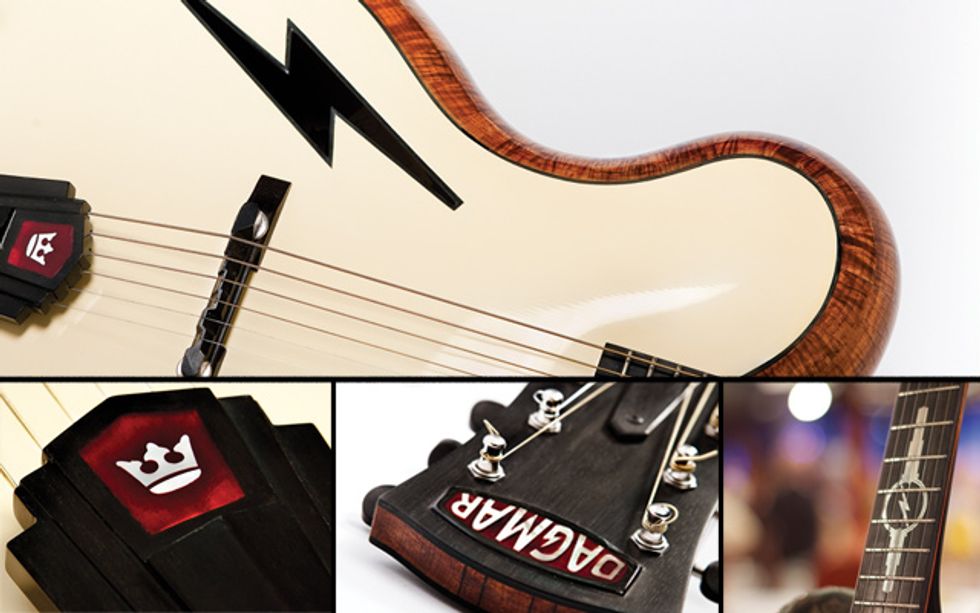
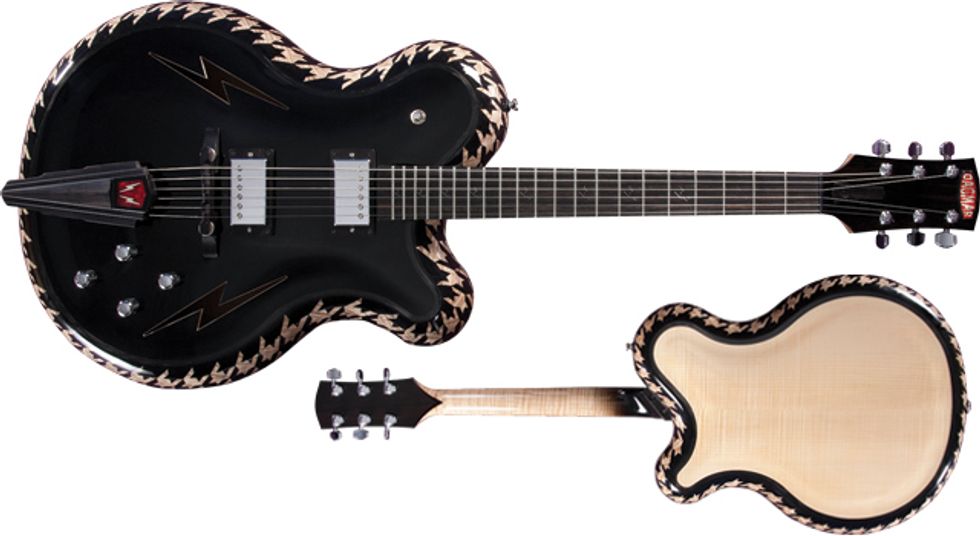
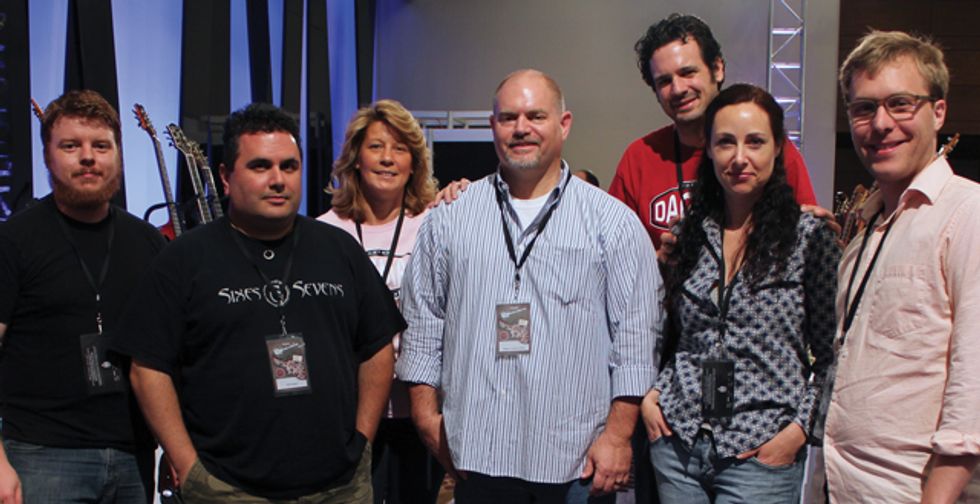
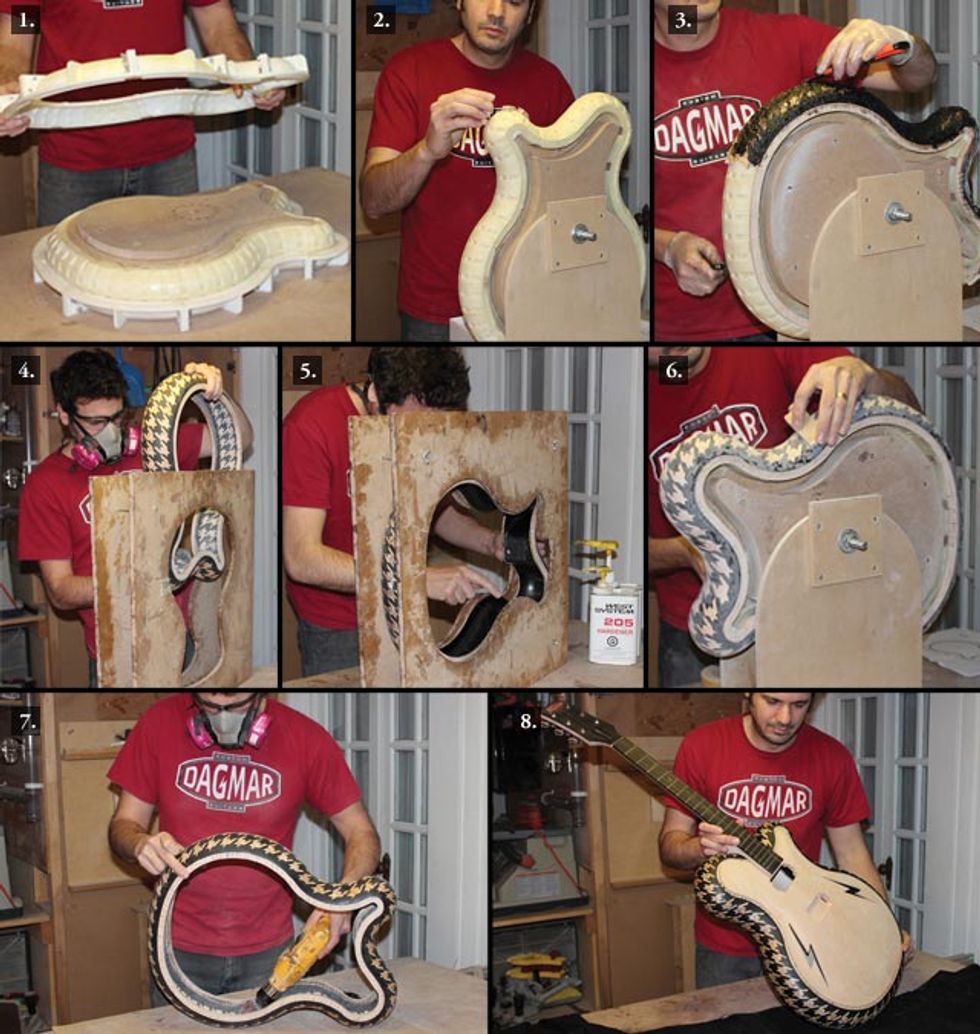
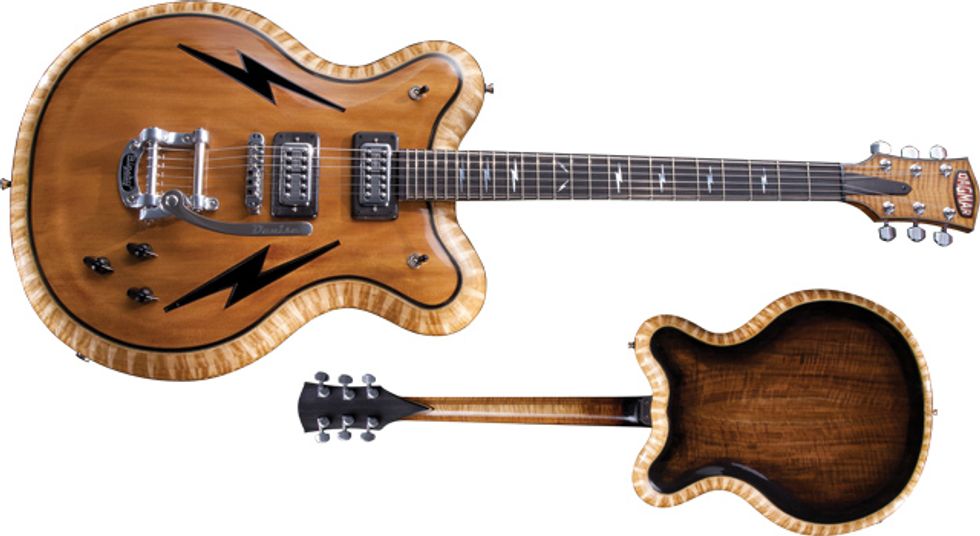
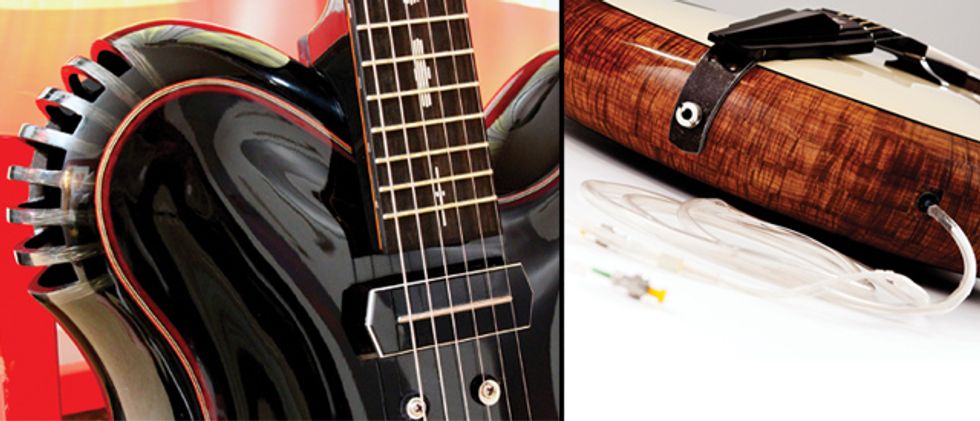
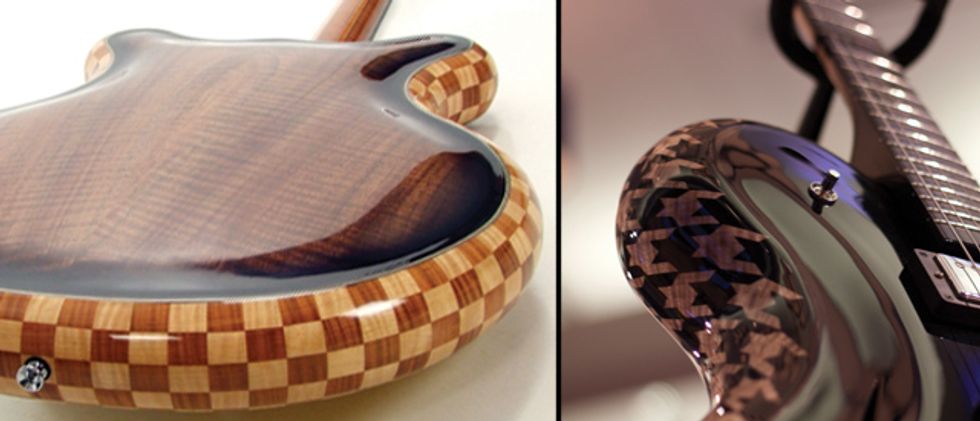
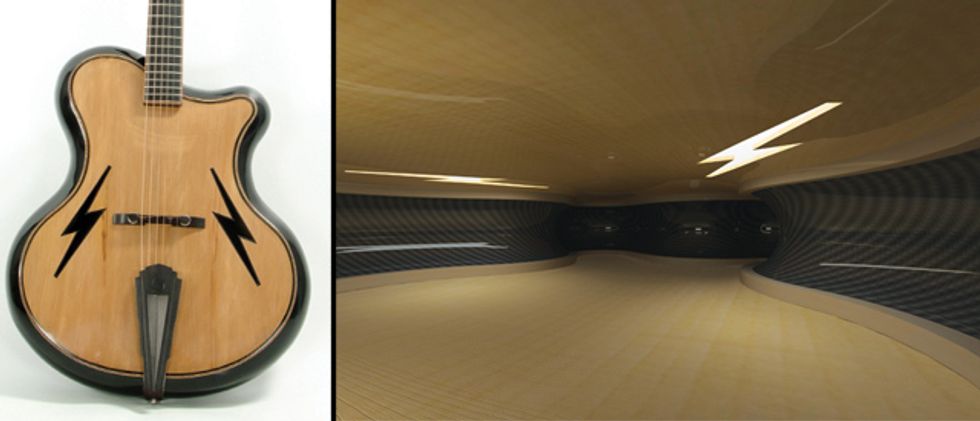




![Rig Rundown: Russian Circles’ Mike Sullivan [2025]](https://www.premierguitar.com/media-library/youtube.jpg?id=62303631&width=1245&height=700&quality=70&coordinates=0%2C0%2C0%2C0)


























